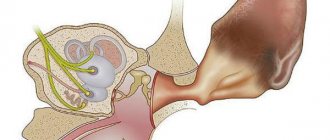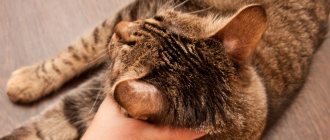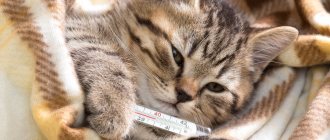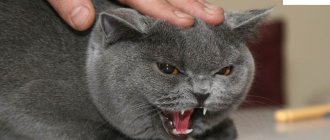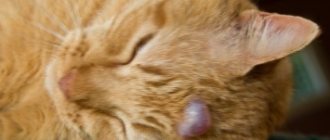In cats, ear diseases are one of the most common among all groups of diseases. The main reason is the complex anatomy of cat ears, which is subject to potential risks. Problems can affect both the visible parts of the ear (pinna, external auditory canal) and those that are inaccessible to the human eye (middle ear, inner ear). An article from “Murkoshi” will help you figure this out.
1) Signs of ear problems 2) Diagnosis 3) Basic ear diseases 4) Treatment 5) Prevention
Signs of ear problems
Normally, cats' ears are shiny and clean, but not wet. The skin inside the ear is a uniform pale pink color. There is no visible discharge in the ear; at most, there may be a small accumulation of light yellow wax without a strong odor. If a kitten develops an ear disease, it will manifest itself with some of the following symptoms:
1. The cat shakes its head and purses its ears. 2. The cat actively scratches its ears and even scratches them until they bleed, resulting in crusts and wounds appearing. 3. There is no (or weakened) reaction to sounds. 4. If you touch the ears at the base, the cat presses them and tries to escape, bites and scratches. 5. Swelling, unnatural growths and bumps are found inside.
Read more: The cat has a swollen ear: what to do
6. The skin in the ear is red, peeling, there are signs of inflammation and crusting. 7. Discharge in the ears ranges from whitish to dark brown. 8. A putrid or sweetish (unnatural) odor comes from the ears. 9. Shortness of breath and nasal discharge are observed. 10. There may be problems with motor coordination and balance.
Hematoma
Another common problem. A cat may well damage its ear during a walk or in a conflict with other animals - domestic or stray. An insect bite may also be the cause. Sometimes cats themselves damage their ears, for example, by scratching them too actively.
The symptoms are quite simple - a swelling appears that is hot to the touch. When touched, the cat flinches, runs away, or becomes aggressive. In some cases, the hematoma resolves and does not cause problems. But sometimes an infection can get into an open wound (and the cat will probably continue to scratch the ear, causing additional damage), which can lead to necrosis of the ear cartilage. After this, the ear will droop and it will be impossible to restore it.
You need to act as decisively as possible. The owner should immediately fix the ear with a bandage and apply cold in the first two days after receiving the wound. After this, you need to apply irritating ointments and heat.
If home treatment does not bring the desired results, you will have to visit a doctor. He will conduct an examination and, if necessary, open the hematoma, carefully removing the dried blood.
Diagnostics
Murkoshi specialists recommend that if you find one or more of the symptoms listed above, immediately take your pet to a veterinary clinic or call a specialist at home. There are many causes of ear diseases in cats; signs, as a rule, can indicate several diseases at once, so without special education it is impossible to make an accurate diagnosis. And untimely treatment can seriously worsen the condition of a mustachioed pet.
Ear diseases in cats can be parasitic, fungal, infectious, inflammatory and traumatic. The color of the discharge from the ears will help determine the cause of the disease (normally, if there is any, it is light yellow - this is the color of earwax). If they are whitish (similar to a curd mass) or yellow, then most likely it is a fungal disease. Yellow-brown discharge indicates bacteria (eg, bacterial otitis media). And if dark brown masses, similar to coffee grounds, accumulate in the ear, then this may indicate that the cat has ear mites.
But for an accurate diagnosis, tests are needed - for example, an ear smear. This will be done at a veterinary clinic. The doctor may resort to a more accurate diagnosis. In any case, immediately or after a while they will tell you what exactly the problem with your ears is and what medications you need to treat it with.
Foreign object in the ear
In general, foreign objects entering the ear cannot be called a disease. However, this happens quite often, so this case should definitely be included in the list.
Most often, parts of plants (leaves or seeds), sand or insect larvae get into the ear. It could also just be a wax plug. The latter usually does not cause discomfort, but significantly impairs hearing. Therefore, the problem must be resolved as quickly as possible.
First of all, it is necessary to remove the foreign object from the ear - this is quite obvious. Alas, it is not always possible to do this on your own. For example, if it is a sharp seed of some weed that has sunk quite deep into the ear. It will be better if a veterinarian handles the extraction. You may even have to use local anesthesia for this - cats are very reluctant to allow a person to delve into their ears.
After removing the object, the ear canal is washed with three percent hydrogen peroxide or soda solution. To reduce the pain reaction (in cases where the inner surface of the ear has been damaged), camphor oil can even be used.
Major ear diseases
Let's look at the most common ailments that often occur in our beloved purrs. 1. Otodectosis . Caused by a microscopic parasite - ear mites. Most cats become infected with it through contact from already sick animals. Ear mites are not transmitted to humans; they are only dangerous to cats and dogs. However, a cat’s good immunity will help cope with the parasite without any special consequences, so either kittens (whose immunity is not yet sufficiently developed) or animals with weakened immunity for one reason or another are susceptible to the disease.
Read more about this disease: Treatment of ear mites in cats
2. Otitis media . One of the most common ear diseases in kittens. In fact, this is a whole group of diseases associated with inflammatory processes in different parts of the ear - external, middle or internal. Most often, otitis media accompanies other ailments and pathologies and develops against their background. The most common are parasitic (complication after otodectosis) and bacterial otitis. If left untreated, otitis media can lead to serious consequences, including complete deafness.
Read more about otitis media: Treatment of otitis media in cats
3. Eczema of the ear . As a rule, it is a complication of inflammation of the outer ear. The most common causes of the disease are foreign bodies, water or chemicals entering the ear.
Read more about what eczema is: How to cure eczema in a cat
4. Polyps and tumors . Both are neoplasms (growths) in the ears. Only polyps are considered benign, and tumors are considered malignant. Polyps occur more often in young animals, and tumors occur more often in older animals. Both formations are removed surgically. In the absence of qualified help, they lead to extremely serious consequences: a polyp can block the eardrum (as a result - its rupture and complete deafness), and a tumor can even lead to death. Fortunately, tumors in cats are relatively rare.
Ear structure
To get a more complete picture, it would be a good idea to learn about this. This is a very complex and delicate instrument that allowed weak animals to survive for many thousands of years.
The ear is divided into three parts by specialists: inner, middle and outer. In turn, each of the parts is further divided into several more.
The parts of the outer ear are the eardrum, the pinna and the ear canal. Their main function is to capture sound and transmit vibrations to the middle ear.
In turn, the middle ear consists of two interconnected chambers. The anvil, malleus and stapes are also located here. Their main function is to amplify sound waves and transmit them to the inner ear.
Finally, it is the inner ear that receives all sounds, which are subsequently processed by the brain. By the way, the labyrinth is located here - the vestibular apparatus, which is responsible for the cat’s balance. Therefore, some diseases that affect a cat's ears can cause loss of coordination and balance. As a result, a dexterous, beautiful, graceful animal turns into a clumsy, barely standing parody of itself. So it is very important to know the symptoms of ear disease in cats. Perhaps thanks to this you will be able to contact a veterinarian in a timely manner and save your pet from such a sad fate.
Treatment
The first step in the treatment of cat ear diseases is to cleanse the auricle of the contents using lotions, such as Ottoclin, Bars, Globalvet, etc. The lotion dissolves dirt, removes secretions out, after which all that remains is to clean them off with a cotton pad . After cleaning the ear, if it was dirty, medicine is instilled there, depending on the causative agent of the disease. The procedures should be carried out for as many days as the doctor recommends.
Antiseptic and antihistamine drugs, as well as insecticidal drops, are used against ear mites. When treating otitis, Otipak, Sofradex or Anandin Plus drops are used. For ear dermatitis, treatment is carried out with a 3-5% solution of boric or picric acid and an ointment such as “Hydrocartisone” or “Geokarton” is applied. After treatment for ear diseases is completed, the cat must be shown to the doctor, he will again do an analysis. He will look at how much the condition has improved and give a conclusion: the end of the procedures or the need to change the drug and continue treatment.
Often, with ear diseases, cats require a drug to relieve itching; tablets or drops can be used orally. Especially if otitis media has developed due to an allergy, then Zordex, Zyrtec, and Tyrosine are used in dosages for animals. Sometimes, when the itching cannot be removed immediately, cats are put on a special collar, attached to the neck with a strap.
To treat parasitic otitis media, you will also need drops on the withers against ticks. It is advisable to repeat the procedure after 28 days to consolidate the result. In this case, you will need to take care of the hygiene of the room in order to protect the cat from re-infection.
The place where the animal lives must be vacuumed, and things (beds, toys, bowls, etc.) must be washed or rinsed thoroughly. Other animals living in the same apartment should also be treated, because even if they do not have ear discharge, they will most likely still be infested with ear mites. Allergic otitis occurs with the main agents - these are bacteria and yeast fungi, malacesia. Drugs for their treatment: “Suralan”, “Mometamax” and the most modern drug “Posatex”.
Ear fungus
In general, ear fungus is present in many cats - even completely healthy ones. But a healthy immune system easily suppresses it, so that the animal does not experience the slightest discomfort. Problems in cats usually begin against the background of weakening of the body. Most often, they affect old animals, as well as those who have recently experienced serious pathologies. For example, high temperature, poisoning and others.
In this case, a brown-black coating appears on the affected areas. Serous exudate may leak from the ears. All this is accompanied by an unpleasant sour smell.
Treatment must be comprehensive. On the one hand, it is very important to suppress the proliferation of fungus. On the other hand, to rid the animal of the root cause of the disease. At the same time, it is very important to increase the animal’s immunity - this will allow the body to effectively fight the fungus and reduce the risk of recurrent disease.
Prevention
The Murkoshi team draws your attention to the need for preventive measures, only in this case you will save your kitten from ear diseases. The most important preventive action is pet hygiene. Teach your kitten from an early age to constant ear cleaning. The procedure must be carried out carefully so as not to injure the tail or cause him pain.
Read more about how to clean ears: How to clean a cat's ears
Clean your cat's ears delicately, speaking gently and stroking them. If everything is done correctly, there will be no complications or resistance to the procedure on the part of the pet. Also, a mandatory measure should be treatment against parasites - external and internal - 2 times a year.
Read more: How to treat a cat for parasites
If you spend time on cat hygiene, then ear diseases will bypass her. But if you still notice alarming symptoms (the cat intensively scratches its ears, does not allow them to be touched, discharge appears in the ears, etc.), do not hope that “maybe it will go away on its own,” but immediately contact a specialist. Only with a correct diagnosis and appropriate prescription is it possible for your pet to recover quickly!
Video “How to clean the ears of a cat and dog”
To prevent the consequences, as in the photo, of the formation of plugs and mites, watch the video for the correct process of cleaning cats’ ears.
Was this article helpful?
Thank you for your opinion!
The article was useful. Please share the information with your friends.
Yes
No (100.00%)
X
Please write what is wrong and leave recommendations on the article
Cancel reply
Rate the benefit of the article: Rate the author ( 7 votes, average: 3.71 out of 5)
Discuss the article:
Necrosis of the auricle
A truly terrible disease, which usually occurs only in cases where milder forms (for example, hematoma or other minor mechanical damage) were not cured in time.
When infection gets into the wounds, inflammation begins, and then ulcers and necrosis of some areas of the ears - this is necrosis. Blood circulation deteriorates, cartilage tissue begins to rot, and the ear becomes severely deformed. A characteristic smell of rotting flesh appears.
Unfortunately, treatment is only possible through surgery. Veterinarians will have to remove either the entire ear or individual areas that have undergone necrosis.


